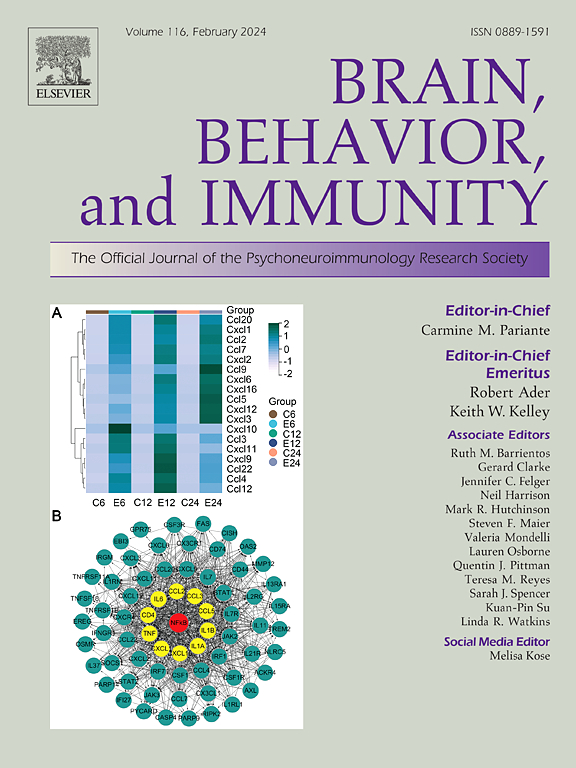Hippocampal GPR35 is involved in the depression-like behaviors induced by inflammation and mediates the antidepressant effects of fluoxetine in mice
IF 8.8
2区 医学
Q1 IMMUNOLOGY
引用次数: 0
Abstract
Background
Neuroinflammation plays a pivotal role in the pathogenesis of depression. G protein-coupled receptor 35 (GPR35) is expressed in the brain and plays a role in regulating inflammatory processes. However, its specific role in depression remains unclear. Herein, we investigate the role of GPR35 in depressive behaviors induced by lipopolysaccharide (LPS) in mice.
Methods
We employed an LPS-induced depression mouse model and conducted behavioral tests, molecular analyses, and morphological assessments, along with chemogenetic techniques, to investigate the role of GPR35 in depression.
Results
Our results showed a significant increase in GPR35 expression in the brain of LPS-treated mice. Both pharmacological inhibition and genetic knockdown of GPR35 alleviated LPS-induced depressive-like behaviors by mitigating neuroinflammation, oxidative stress, synaptic plasticity deficits, and TLR4/NF-κB signaling in mice. Conversely, pharmacological activation of GPR35 notably exacerbated LPS-induced depressive-like behaviors in mice. Additionally, the GPR35 antagonist ML-145 effectively prevented LPS-induced inflammation responses in BV-2 microglia cells. Moreover, fluoxetine treatment effectively mitigated the upregulation of hippocampal GPR35 expression induced by LPS in mice. However, administration of the GPR35 agonist zaprinast reversed the antidepressant effects of fluoxetine. Chemogenetic activation of hippocampal glutamatergic neurons attenuated LPS-induced depression-like behaviors, accompanied by decreased GPR35 expression.
Conclusion
Hippocampal GPR35 is closely associated with depressive behaviors in the inflammatory model, highlighting its potential as a therapeutic target for antidepressant drug development.
求助全文
约1分钟内获得全文
求助全文
来源期刊
CiteScore
29.60
自引率
2.00%
发文量
290
审稿时长
28 days
期刊介绍:
Established in 1987, Brain, Behavior, and Immunity proudly serves as the official journal of the Psychoneuroimmunology Research Society (PNIRS). This pioneering journal is dedicated to publishing peer-reviewed basic, experimental, and clinical studies that explore the intricate interactions among behavioral, neural, endocrine, and immune systems in both humans and animals.
As an international and interdisciplinary platform, Brain, Behavior, and Immunity focuses on original research spanning neuroscience, immunology, integrative physiology, behavioral biology, psychiatry, psychology, and clinical medicine. The journal is inclusive of research conducted at various levels, including molecular, cellular, social, and whole organism perspectives. With a commitment to efficiency, the journal facilitates online submission and review, ensuring timely publication of experimental results. Manuscripts typically undergo peer review and are returned to authors within 30 days of submission. It's worth noting that Brain, Behavior, and Immunity, published eight times a year, does not impose submission fees or page charges, fostering an open and accessible platform for scientific discourse.

 求助内容:
求助内容: 应助结果提醒方式:
应助结果提醒方式:


